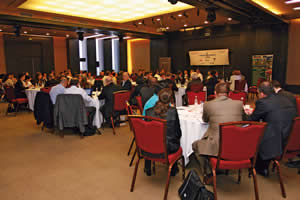State of uncertainty
Lack of strong Government incentives and unclear laws are holding back rapid development of green energy in Romania
 |
|
|||||||||||||
Romania is behind its fellow EU countries in encouraging the development of renewable energy, although the country has unrivalled resources in the southeastern wing of the 27 member-bloc.
‘The Diplomat’ gathered together project developers, financiers and state energy companies and agencies to discuss renewable energy in Romania, how to finance projects and practical incentive schemes for future development.
At present around 30 per cent of Romania’s energy is supplied by hydro power, while 0.01 per cent uses wind. Only in these two areas and in biomass is the country witnessing strong renewable development.
This event, held at the Howard Johnson Hotel in June, was organised with law firm Schoenherr, engineering company ABB, NSS Global Investment and energy firm McBurney.
Power status
Mark Newbery, partner, Herbert Smith
We are facing serious challenges in the energy sector. The global economy is set to grow fourfold between today and 2050 and tenfold in developing countries. There will be a 70 per cent increase in oil demand by 2050 and a 130 per cent increase in CO2 emissions.
There is a global revolution needed in the way energy is supplied and used, which will include green energy and nuclear power and CO2 capture and storage. It’s not about competition between forms of power generation, everything is necessary. What this requires is a shift in Government policies and the transformation of the global energy economy. What the G8 is looking for is to cut by 50 per cent of current levels by 2050. We need clear, predictable and long-term incentives for CO2 reductions.
Peter Simon, ABB Romania general manager
Every day we use oil, and the level of oil goes down. Everyday the sun comes up, so this is something we have to look into. The sun is the biggest reserve in our world and it is easier to finance such projects.
Markus Piuk, partner, Schoenherr
Green energy has become an important part of the Austrian economy. On Austrian rooftops we see photovoltaic cells for solar energy, near Vienna’s airport we see wind parks all over regions, but Romania is better designed for wind farms than Austria. Romania could become the most influential market for green energy in the region. There are some good hydro power stations up and running and Romania has some micro hydro power stations. But there are not enough turbines in Romania.
Tudor Constantinescu, president, Romanian Agency for Energy Conservation (ARCE)
Romania has concrete targets on reduction of CO2 and renewable energy from 17.8 per cent in 2005 to 24 per cent in 2020. Romania has high potential for increasing energy efficiency. It still has high energy prices and the energy intensity adjusted with the purchasing power of Romanians and the structure of the economy is still high in Romania compared with the EU15. The importance given to energy efficiency is very low. We need wind, biomass, solar and, depending on costs, they will find their way to market. I doubt the Government will support certain technologies to the detriment of others to help Romania meet its obligations.
John McBurney, president, McBurney BioEnergy
We are developing additional technology to create energy from agricultural waste, from food processing industries, sugar industry and corn processing. A largely unnoticed fuel is municipal waste, which is another biomass. Landfills generate methane gas that can be collected, captured and burned as electricity. Municipal district heating can be used using municipal waste.
Projects: wind
Carmen Marin, commercial manager, power business unit, Petrom
Petrom wants to invest in the green power sector in Romania. We have put in our strategy to invest in a greenfield project. In wind energy we are looking into two projects. One in Dobrogea is under analysis. By 2011 one of our projects will be commissioned.
Nuno Alemao, managing director Eviva [a part of Martifer]
In Romania, Martifer has one wind farm that we expect to see erected in 2008. The turbines are due to arrive very shortly. We have a civil license and need an electrical license. This year we will be ready for 90 MW and intend to reach 150 MW by 2010.
Tomasso Di Fazio, head of institutional affairs, Enel Romania
We have plans in Dobrogea to develop wind plants. [This is through the purchase of Blue Line, a Romanian company that holds the rights to develop wind energy projects in Dobrogea. These projects are due to be operational in 2010].
Peter Simon, ABB
We set up a 28 MW project that was supposed to happen in the port of Constanta ten years ago. But the process took too long and we decided not to continue. It was too early for Romania. Now it would be different.
Cristian Georgescu, president, Rokura
After four years of development we have struck a good deal with [Spanish energy giant] Iberdrola, selling the rights for 600 MW in the Dobrogea area. We are proceeding well. The erection will start next year. The environmental impact assessment (EIA) has to be created. The first megawatts should start in mid 2009. The plan is to have more projects for farms. We welcome finance for implementation and are looking for alliances and partnerships with major operators.
Fabrizio Cagnasso, director, Continental Wind Partners
We are developing projects in Poland, Croatia and have joint ventures in Australia and New Zealand. We are planning more wind farms, not only in eastern Europe, but also worldwide. One big problem is the turbine supply. In Dobrogea there is a 345 MW project and a second 255 MW under development and possibly smaller projects in that area. We are starting to consider the development region on Moldavia. We are looking for financing from direct operators and have some contact with big operators.
Radu Voinescu, expansion manager, Bogaris
We are developing a feasibility study on our most advanced projects [in Dobrogea] and things are looking good, but moving slowly.
Projects: biomass
John McBurney, McBurney BioEnergy
We are working on our third biomass project since 1997, with one in Transylvania, a second in Bucovina and a third also due for Transylvania. We use wood-base as a bi-product from manufacturing basis as a biomass. In green energy projects, one needs to allow for a longer payback time of maybe eight years. Some projects have a life-cycle of 30 or 40 years. Some biomass projects based on fuel generated as a waste biomass is captured, in other cases it has to be sourced. The farmer purchases land and grows biomass as an energy product, such as a willow tree, fast growing straw or grass, with each one requiring a different type of combustion technology. Garbage is a difficult fuel to use, but is in ready supply in Romania.
Holding back the wind
Cristian Georgescu, Rokura
For 50 wind farms in Dobrogea there is the topographical and cadastrial lack of data and the troubles with property inheritance. But I offer a message of hope. You have to press the authorities to give security on large and small investments.
Markus Piuk, Schoenherr
There are a lot of halfway developed wind projects from the license point of view. [Developers] need to get as many technical permits as possible, but there is limited grid capacity in areas for wind farms.
Mihnea Craciun, principal banker power and energy, European Bank for Reconstruction and Development (EBRD)
Turbine manufacturers need two years to process an order. This is why smaller investors have a disadvantage. Larger investors have already placed big orders, but smaller investors have to pay advanced payments for turbines.
The EIA is also a concern. Unfortunately there is less experience in Romania about this to develop this kind of study. Objectively people don’t have the experience or track record. We are very much looking into this and taking it into account when analysing projects
Dobrogea is earmarked for a number of big investments in the future for nuclear and all power has to be evacuated from the area, because it’s not a place where energy is consumed.
Cristian Georgescu, Rokura
Wind project development and measurements need to have a bankable database that is credible. Of paramount importance is to be well aware and make correct assessment of the needs of connection to the grid and the technical requirements.
The most important factor in the due diligence undertaken by Iberdrola was not the technical, legal or least of all, financial, it was the evaluation of the opportunity itself and the certainty of it all. Unless there is long-due law on the table of parliament, I would not see large investment.
Nuno Alemao, Eviva
When a developer interacts with suppliers real problems will arise. We have to make a geotechnical study to make the correct design and foundations. This price was four times more than we were used to in Portugal. The price for materials is high. The price for concrete is 130 Euro per cubic metre compared to 89 to 93 Euro per cubic metre in Portugal. This is just the beginning. In 2008 in Romania the price is already 1.5 million Euro per Megawatt. Financial projects will start to be doubtful. The licensing process is very painful and the construction is painful. The ports are still not well equipped. We had to bring our own cranes from Portugal to pick our turbine up. Labour costs are increasing. Developing wind farms will be profitable, but there may be places more attractive than Romania, even when there is so much potential here.
Radu Voinescu, Bogaris
The only limited resource we are competing on is land. Resources such as wind and sun are unlimited and we only have to timetable them, such as turbines. So renewable energy developers should speak together as a group. Then we can speak as a total investment of billions rather than 100 millions.
Nuna Alemao, Eviva
The local authorities need to be approached by a central process. It can take a very long time to acquire building permits from local authorities – the gap needs to be closed between local and central authorities. On the electrical part, why not place the transport and distribution licenses in one unique license with Transelectrica, Electrica and the private distributors?
Mark Velody, team leader, Energy Consulting Network System
We are running a programme for the Ministry of Economy and Finance with PHARE funding on what to do about renewable energy, what steps need to be taken to make the economic potential happen. We need to see what the barriers there are on the ground. If [developers] cannot get permission and no one is taking notice or cannot understand legislation. We are listening to the problems, forming the solutions and then giving this to the Government.
Financing opportunities
Valentin Cudric, investment director, NBGI Private Equity
We are looking for projects to finance. This depends on how long it will take to be operational, how long it will take to obtain the license and what is the price of the [carbon-trading] green certificates. In Romania, you have to first find what will the energy price be, and then find out the green certificate price on the market. There is higher uncertainty and risks in this kind of market. The three main parameters are licensing, a country’s capacity for wind and the price in the market for energy and green certificates.
Mihnea Craciun, EBRD
We are working with Transelectrica on a number of projects, such as financing interconnections with Hungary, and making studies with Transelectrica related to the capacity of interconnecting renewable energy projects.
In financing EBRD has an advantage over commercial banks. They are willing to go in if we are going into projects and sometimes we are first timers. The EBRD has a good role in the energy sector, especially in renewables, but there needs to be an integrated effort from all stakeholders.
Florian Filat, manager municipalities, state entities and EU programmes, Bancpost
We are interested in financing projects in this field. We do not have much experience with companies interested in wind energy. We want to identify bankable projects.
Making connections
Radu Voinescu, Bogaris
With the permit to connect to the grid, there is a problem with the available capacity of the grid. When it comes to connecting to [distributor] Electrica Muntenia Nord, 100 MW are not possible. In areas with the most important wind energy potential, a developer has to build a high voltage line. This is not economically feasible, even if the developer is ready to support the distributor to upgrade the system.
Ciprian Diaconu, director, technical division assets, planning, ITC for power grid company Transelectrica
I receive several applications and cannot say which is serious and which is not. Up to May 2008, we have received applications for 6,701 MW, some of which are in the south part of Moldavia. So far we have given permission for connection and distribution for up to almost 1,600 MW installed capacity. All the projects are in the Dobrogea area. The situation in Romania is difficult because we don’t know with whom we are dealing with. Investors should put their efforts together and try to deal together with Transelectrica, and then we can try to rewrite the legislation in such a way to have real projects.
Connection will be possible also for larger quantity [than 1,600 MW], but not tomorrow. We have to develop infrastructure, approved by the regulator and Government and to secure investment.
Peter Simon, ABB
We are changing the transformation side. Instead of Transelectrica putting electricity in a system and feeding it to the end-user, [with renewable energy such as solar and wind] we have the source on the other end and feed it into the system.
Fighting for incentives
There are two main Government incentives for energy companies to develop renewables: feed-in tariffs and green certificates.
With feed-in tariffs, electricity utilities must buy renewable electricity at above market rates to off-set the high costs of renewable power generation. This is because the retail price of energy from renewables is higher than those from fossil fuels. Different forms of green power may command different costs. Germany, Spain and Denmark used this model, as well as Bulgaria, Greece and Turkey. The expenses for the electricity utilities for buying from renewable energy sources are passed on to the customer, but because the proportion of energy bought is low, the costs are spread widely. As the proportion of green energy continues to increase, so the price should, in theory, drop. This method is not favoured by the Romanian Government.
Green certificates are tradable environmental commodities representing one MW of electricity produced by green energy. Under the Kyoto Protocol a country producing over its quota of carbon gas then buys green certificates from developing countries. This sets into train the mechanism of an emission trading system. Green certificates are used in the UK, Italy, Poland, Belgium and Sweden. A new project of law has passed in the Romanian senate to reform this system locally.
Markus Piuk, partner, Schoenherr
The feed-in system allows smaller projects to access finance and funds. However feed-in tariffs are an unnecessary intervention in market forces and may be somehow in contradiction with what the EU stands for.
Mark Newbery, Herbert Smith
The primary mechanism the EU will use is the Emission Trading System [ETS]. Feed-in tariffs mean the Government can select favourable technologies and Governments are not good at selecting technologies. The UK’s equivalent of feed-in tariffs produced one of the most expensive projects ever delivered. There is a trade-off between the certainty of financing offered by feed-in tariffs and the potential of very high costs. The European Commission has looked into whether we can harmonise the system or phase out feed-in tariffs. But this is politically too hard for them, so the feed-in tariffs we have will stay. How do you reconcile feed-in tariffs with some technologies versus other technologies which rely on carbon markets? There is a contradiction between these two which has to be resolved.
Markus Piuk, Schoenherr
The green energy market is underdeveloped in Romania. Will feed-in tariffs get started and then be phased out in ten to 15 years?
Mark Newbery, Herbert Smith
Feed-in tariffs would give certainty of financing for delivering projects. But the idea of introducing feed-in tariffs with a view to phasing them out is difficult. Like any subsidy, it becomes addictive quite quickly.
Peter Simon, ABB
Feed-in targets are in Germany and Spain, where there is the highest investment, not in UK or Italy.
Mark Newbery, Herbert Smith
Those countries were successful, but at what price? An investor wants the certainty of feed-in tariffs, but is that sustainable? If populations are prepared to pay for higher electricity tariffs, that is fine. But I question whether companies gain the lowest cost for renewables with feed-in tariffs. And if you have feed-in tariffs for renewables, why not a feed-in tariff for nuclear? Why not for everything else?
Tudor Constantinescu, ARCE
The difference between investing in energy efficiency and buying green certificates on an EU carbon market could range up to 500 to 800 million Euro a year from now until 2020. We need to look at how to reach carbon targets at the lowest costs and at the same time develop both the market and technologies which are investing in these renewable projects.
Radu Voinescu, Bogaris
Romania has the fewest subsidies and government aids in states of eastern Europe and it is the least developed in its capacity in green energy. I believe there is a correlation between the two.
Mike Newbery, Herbert Smith
We can envisage a world of 200 USD for a barrel of oil, which will feed back into carbon prices.
We could have feed-in tariffs set for 15 years, but [those partaking] could get trapped into it and at five years plead to leave, because carbon prices are so high, they could make more money at current carbon prices. So much will depend on the path of future oil price and how that will feed back into prices. This is also the biggest incentive to green energy.
Mihnea Craciun, EBRD
Investors who come to us are concerned about a number of issues. The first is related to green certificate trading, which is valid until 2012. There are a number of proposals put forward by the National Regulatory Authority (ANRE), the Parliament and the Government, which have not been passed yet. Investors are waiting regarding new rules. It is not a matter of selecting between green certificates and feed-in tariffs. It is a green certificate market.
New horizons for Romanian renewables
Mark Velody, Energy Consulting Network System
[Many stakeholders have told us] all the money is going to wind electricity and no one is taking any notice of solar and geothermal energy. All people who want to invest in wind are waiting to see what will happen to the [EU] cohesion funds. All think the projects which will end up being beneficiaries of cohesion funds will go ahead and the ones that don’t will not go ahead. There is uncertainty about how the EU money will be spent.
Cristian Georgescu, Rokura
There is a huge potential for research and development in Romania in this country. There is a very solid platform for hydrogen and very significant funds will be spent on hydrogen research fossil fuels, coal, methane gas, but with less consumption to decrease CO2 emissions. We have our own efforts which are sponsored by the Romanian Government with pilot installations. There are funds, foundations and other financial institutions that could get involved.
Gheorghe Olteanu, energy research and modernisation institute, ICEMENERG
We have a small windmill of 15 kw on top of our six-floor building in Bucharest, which is able to heat 1.5 tonnes of water per hour, and a photovoltaic generator. We are a consultancy that helps to promote small projects in photovoltaic, solar panelling and windmills to owners of big houses in mountain areas. We are also helping in the feasibility study to transform the wlargest building in Romania, the Parliament Building, into an energy efficient building.
Fabrizio Cognasso, Continental Wind Partners
It is clear that Romania must be part of a wider scheme. EU directives requiring renewables are quite straightforward. These targets are not equally achievable for different countries. To improve investment, we need stable and long-term law regarding renewables.
Gheorghe Olteanu, ICEMENERG
We cannot make further improvements in all matters until we introduce another kind of organisation of the energy sector in Romania [currently proposed by Minister of Economy and Finance Varujan Vosganian unifying regional electrical distribution companies and state power companies in the nuclear, thermo and hydro power field].

















